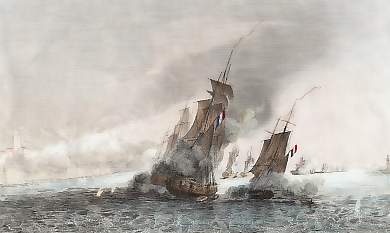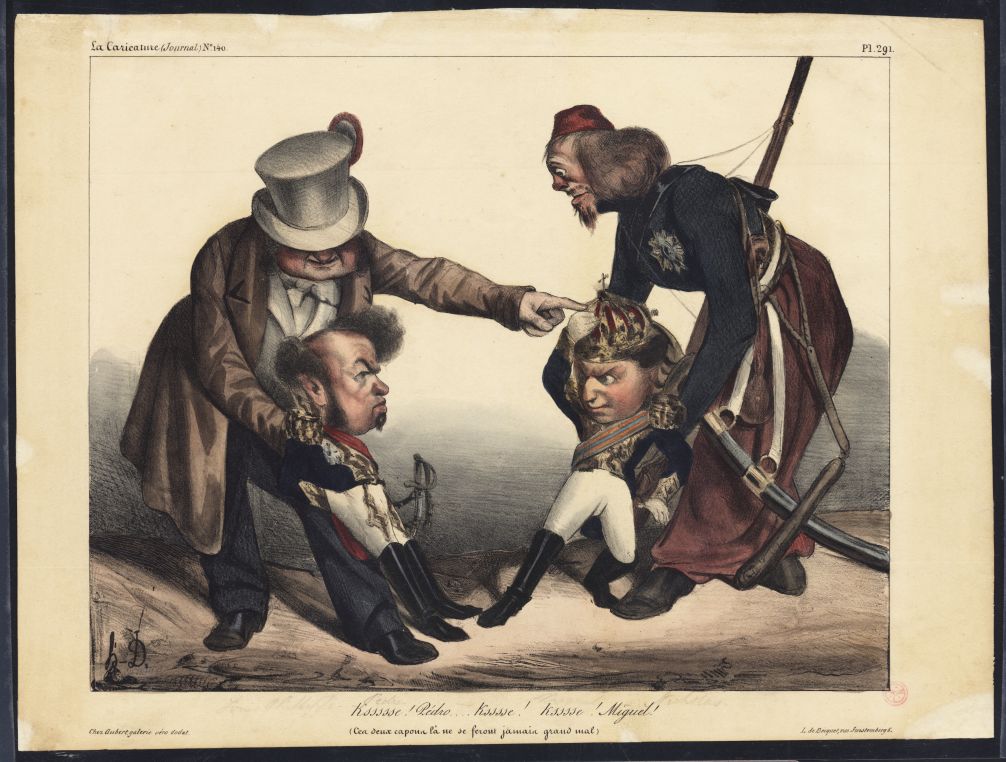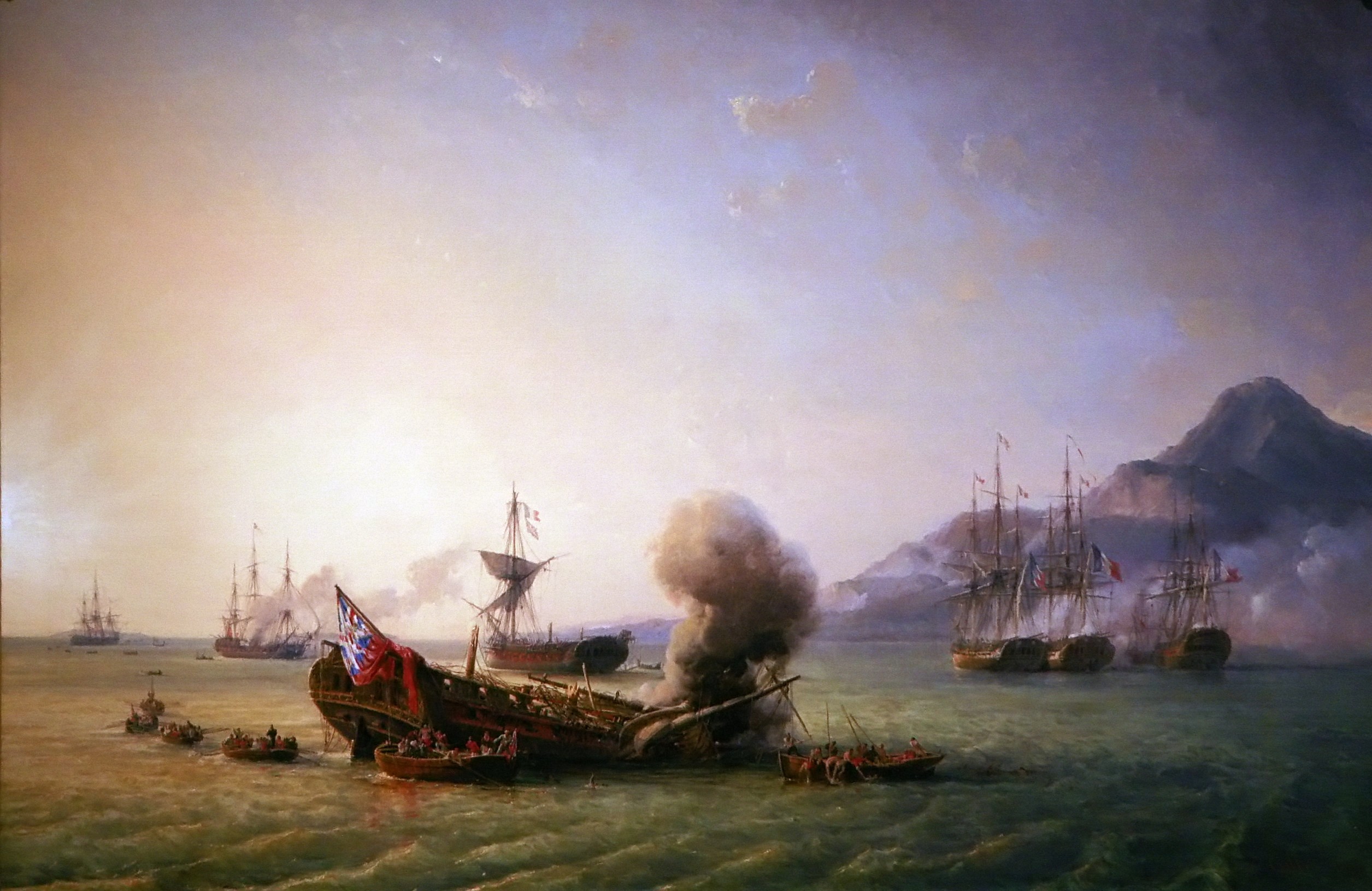|
Battle Of The Tagus
The Battle of the Tagus was a naval engagement that took place on 11 July 1831 at the mouth of the Tagus river, in Portugal. A French fleet attacked and subdued Portuguese fortifications at the entrance of the Tagus, with the aim to strong-arm the government of Miguel I into recognising the newly established Kingdom of the French. The damage to the forts defending access to the Tagus and the arrival of French warships at Lisbon forced the Portuguese to cave in and comply with French demands. Background The accession of King Miguel I to the throne of Portugal and abolition of the Constitutional Charter had put the country under the rule of an absolutist monarch. Liberals challenged his rule, and the struggle of the Liberal Wars ensued. The government of Miguel I was hostile to France, and became even more so when the popular insurrection of the July Revolution deposed the absolutist Bourbon king Charles X, and established a constitutional monarchy in which Louis-Philippe ha ... [...More Info...] [...Related Items...] OR: [Wikipedia] [Google] [Baidu] |
Liberal Wars
The Liberal Wars (), also known as the Portuguese Civil War (), the War of the Two Brothers () or Miguelite War (), was a war between liberal constitutionalists and conservative absolutists in Portugal over royal succession that lasted from 1828 to 1834. Embroiled parties included the Kingdom of Portugal, Portuguese rebels, the United Kingdom, France, the Catholic Church, and Spain. Roots of the conflict The death of King John VI in 1826 created a dispute over royal succession. While Dom Pedro, the Emperor of Brazil, was the king's oldest son, his younger brother Miguel contended that Pedro had forfeited his claim to the throne by declaring Brazilian independence. Pedro briefly entitled himself Dom Pedro IV of Portugal. Neither the Portuguese nor the Brazilians wanted a unified monarchy; consequently, Pedro abdicated the Portuguese throne in favor of his daughter, Maria, a child of 7. In April 1826, to settle the succession dispute, Pedro revised the first constitution o ... [...More Info...] [...Related Items...] OR: [Wikipedia] [Google] [Baidu] |
French Brig Endymion (1828)
''Endymion'' was a 20-gun brig of the French Navy, designed by Barallier. Career Commissioned under Captain Crespel, she sailed in the Caribbean and off Brazil. She took part in the ''Didon'' took part in the Invasion of Algiers in 1830 under Lieutenant Nonay, landing troops at the attack on fort Mers-el-Kebir, and in the Battle of the Tagus The Battle of the Tagus was a naval engagement that took place on 11 July 1831 at the mouth of the Tagus river, in Portugal. A French fleet attacked and subdued Portuguese fortifications at the entrance of the Tagus, with the aim to strong-arm ... the next year. On the Tagus, she ferried the last diplomatic demarches before the French assault on Lisbon. Notes and references References Bibliography * {{DEFAULTSORT:Endymion (1828) Age of Sail corvettes of France Ships built in France 1824 ships ... [...More Info...] [...Related Items...] OR: [Wikipedia] [Google] [Baidu] |
French Ship Algésiras (1823)
The ''Algésiras'' was an 80-gun ''Bucentaure''-class 80-gun ship of the line of the French Navy, designed by Sané. She took part in the Invasion of Algiers in 1830, under Captain Ponée, and in the Battle of the Tagus the next year, under Captain Moulac. In 1832, she was used as a troopship to ferry troops to Algeria. In 1836, she cruised the Caribbean with ''Artémise''. ''Algésiras'' was featured in ''Les Misérables ''Les Misérables'' ( , ) is a French historical novel by Victor Hugo, first published in 1862, that is considered one of the greatest novels of the 19th century. In the English-speaking world, the novel is usually referred to by its origin ...'', where she is mislabeled as a frigate: References * Jean-Michel Roche, ''Dictionnaire des Bâtiments de la flotte de guerre française de Colbert à nos jours'', tome I {{DEFAULTSORT:Algesiras Ships of the line of the French Navy Ships built in France Bucentaure-class ships of the line 1823 ship ... [...More Info...] [...Related Items...] OR: [Wikipedia] [Google] [Baidu] |
Vincent Moulac
Vincent-Marie Moulac (Lorient, 22 March 1778 – Callao, 5 April 1836) was a French naval officer and privateer. Career Moulac volunteered as a boy in 1790, aged 12, and sailed with merchantmen to Ile de France. He then served on the 74-gun ''Thémistocle''. In 1793, promoted to helmsman, he served on ''Orion''. In 1794, he was promoted to midshipman and appointed to the frigate ''Bellone''. In May 1796, he served on the privateer ''Morgant'', which was captured by the British in June. Moulac was detained for two years before being released. By the Peace of Lunéville in 1801, he was serving on the frigate ''Uranie'', but as he was only an auxiliary officer, he could not maintain his appointment and had to sail to commerce. He later served as a first lieutenant on the privateer ''Frères Unis'', only to be captured again on 27 April 1804. A few months later, he was recruited by Robert Surcouf to serve as first officer on his privateer ''Caroline'', under Nicolas Surcouf. ... [...More Info...] [...Related Items...] OR: [Wikipedia] [Google] [Baidu] |
Combat Du Tage 3
Combat ( French for ''fight'') is a purposeful violent conflict meant to physically harm or kill the opposition. Combat may be armed (using weapons) or unarmed ( not using weapons). Combat is sometimes resorted to as a method of self-defense, or can be used as a tool to impose one's will on others. An instance of combat can be a stand-alone confrontation or a small part of a much larger violent conflict. Instances of combat may also be benign and recreational, as in the cases of combat sports and mock combat. Combat may comply with, or be in violation of local or international laws regarding conflict. Examples of rules include the Geneva Conventions (covering the treatment of people in war), medieval chivalry, the Marquess of Queensberry rules (covering boxing) and several forms of combat sports. Hand-to-hand combat Hand-to-hand combat (melee) is combat at very close range, attacking the opponent with the body ( striking, kicking, strangling, etc.) and/or with a melee ... [...More Info...] [...Related Items...] OR: [Wikipedia] [Google] [Baidu] |
French Ship Suffren (1824)
The ''Suffren'' was a 90-gun Ship of the line of the French Navy, lead ship of her class. She was the third ship in French service named in honour of Pierre André de Suffren de Saint Tropez. Career The ''Suffren'' was the first ship of the line built with straight sides, after the specifications of the Commission de Paris, instead of the traditional tumblehome common on ships of the line. She took part in the Battle of Tagus on 11 July 1831, under Captain Trotel, as Albin Roussin's flagship, and stayed off Lisbon for one month thereafter, leaving Portugal on 14 August. The next year, she took part in the Battle of Ancona, on 22 February, ferrying 1500 infantrymen. In 1838 she ran aground near Cádiz after a tempest. She was refloated by the steam ships ''Iéna'' and ''Phare''. She took part in the war against Morocco in August 1844, bombing Tangier on the 6 August and landing troops in Mogador on 16. In 1854, ''Suffren'' was involved in the Crimean War. In July, an e ... [...More Info...] [...Related Items...] OR: [Wikipedia] [Google] [Baidu] |
Battle Of Grand Port
The Battle of Grand Port was a naval battle between squadrons of frigates from the French Navy and the British Royal Navy. The battle was fought during 20–27 August 1810 over possession of the harbour of Grand Port on Isle de France (now Mauritius) during the Napoleonic Wars. The British squadron of four frigates sought to blockade the port to prevent its use by the French through the capture of the fortified Île de la Passe at its entrance. This position was seized by a British landing party on 13 August and, when a French squadron under Captain Guy-Victor Duperré approached the bay nine days later, the British commander, Captain Samuel Pym, decided to lure them into coastal waters where his forces could ambush them. Four of the five French ships managed to break past the British blockade, taking shelter in the protected anchorage, which was only accessible through a series of complicated routes between reefs and sandbanks that were impassable without an experienced har ... [...More Info...] [...Related Items...] OR: [Wikipedia] [Google] [Baidu] |
Mauritius Campaign Of 1809–1811
The Mauritius campaign of 1809–1811 was a series of amphibious operations and naval actions fought to determine possession of the French Indian Ocean territories of Isle de France and Île Bonaparte during the Napoleonic Wars. The campaign lasted from the spring of 1809 until the spring of 1811, and saw both the Royal Navy and the French Navy deploy substantial frigate squadrons with the intention of disrupting or protecting trade from British India. In a war in which the Royal Navy was almost universally dominant at sea, the campaign is especially notable for the local superiority enjoyed by the French Navy in the autumn of 1810 following the British disaster at the Battle of Grand Port, the most significant defeat for the Royal Navy in the entire conflict. After their victory, the British used the original Dutch name of Mauritius for Isle de France. In 1814, Île Bonaparte was returned to France, who eventually renamed it La Réunion. The Royal Navy had been planning an oper ... [...More Info...] [...Related Items...] OR: [Wikipedia] [Google] [Baidu] |
Henri De Rigny
Marie Henri Daniel Gauthier, comte de Rigny (; 2 February 1782 – 6 November 1835) was the commander of the French squadron at the Battle of Navarino in the Greek War of Independence. Biography Family He was a nephew of Baron Joseph Dominique, baron Louis, and son of a former captain in the Penthièvre Dragoon regiment, and who died leaving five small boys, including his brother, the future General Rigny. The French Revolution led him out of the Pont-à-Mousson school, where he had been sent. He was ten years old then, had lost his father and his mother was listed as the list of emigrants. An aunt collected the family, consisting of a young girl of sixteen years and five boys, including Henry, the eldest. Entry in the Naval Forces After spending several months in Special School in Brest, where he had been sent there to finish his studies, in 1798, he entered the navy as a midshipman with Admiral Étienne Eustache Bruix. In 1799 he was appointed midshipman. He assisted ... [...More Info...] [...Related Items...] OR: [Wikipedia] [Google] [Baidu] |
Terceira Island
Terceira () is a volcanic island in the Azores archipelago, in the middle of the North Atlantic Ocean. It is one of the larger islands of the archipelago, with a population of 53,311 inhabitants in an area of approximately . It is the location of the Azores' oldest city, Angra do Heroísmo, the historical capital of the archipelago and UNESCO World Heritage Site; the seat of the judicial system (Supreme Court); and the main Air Force base, Base Aérea nº 4 at Lajes, with a United States Air Force detachment. The island has two main sea ports, one at Angra do Heroísmo and the other at Praia da Vitória, and a commercial airport integrated with the flight operations at Base Aérea nº 4. The Portuguese bullfight is popular on the island, coming in two variations: the traditional equestrian bullfight (in the ring) and the popular " touradas à corda" that occur in the streets. History In 1439, the first official discovery document appeared, attributing the discovery of the ... [...More Info...] [...Related Items...] OR: [Wikipedia] [Google] [Baidu] |
Azores
) , motto =( en, "Rather die free than subjected in peace") , anthem= ( en, "Anthem of the Azores") , image_map=Locator_map_of_Azores_in_EU.svg , map_alt=Location of the Azores within the European Union , map_caption=Location of the Azores within the European Union , subdivision_type=Sovereign state , subdivision_name=Portugal , established_title=Settlement , established_date=1432 , established_title3=Autonomous status , established_date3=30 April 1976 , official_languages=Portuguese , demonym= ( en, Azorean) , capital_type= Capitals , capital = Ponta Delgada (executive) Angra do Heroísmo (judicial) Horta (legislative) , largest_city = Ponta Delgada , government_type= Autonomous Region , leader_title1=Representative of the Republic , leader_name1=Pedro Manuel dos Reis Alves Catarino , leader_title2= President of the Legislative Assembly , leader_name2= Luís Garcia , leader_title3= President of the Regional Government , leader_name3=José Manuel Bolieiro , l ... [...More Info...] [...Related Items...] OR: [Wikipedia] [Google] [Baidu] |
French Brig Hussard (1827)
French (french: français(e), link=no) may refer to: * Something of, from, or related to France ** French language, which originated in France, and its various dialects and accents ** French people, a nation and ethnic group identified with France ** French cuisine, cooking traditions and practices Fortnite French places Arts and media * The French (band), a British rock band * "French" (episode), a live-action episode of ''The Super Mario Bros. Super Show!'' * ''Française'' (film), 2008 * French Stewart (born 1964), American actor Other uses * French (surname), a surname (including a list of people with the name) * French (tunic), a particular type of military jacket or tunic used in the Russian Empire and Soviet Union * French's, an American brand of mustard condiment * French catheter scale, a unit of measurement of diameter * French Defence, a chess opening * French kiss, a type of kiss involving the tongue See also * France (other) * Franch, a surname * Frenc ... [...More Info...] [...Related Items...] OR: [Wikipedia] [Google] [Baidu] |






_(cropped).jpg)